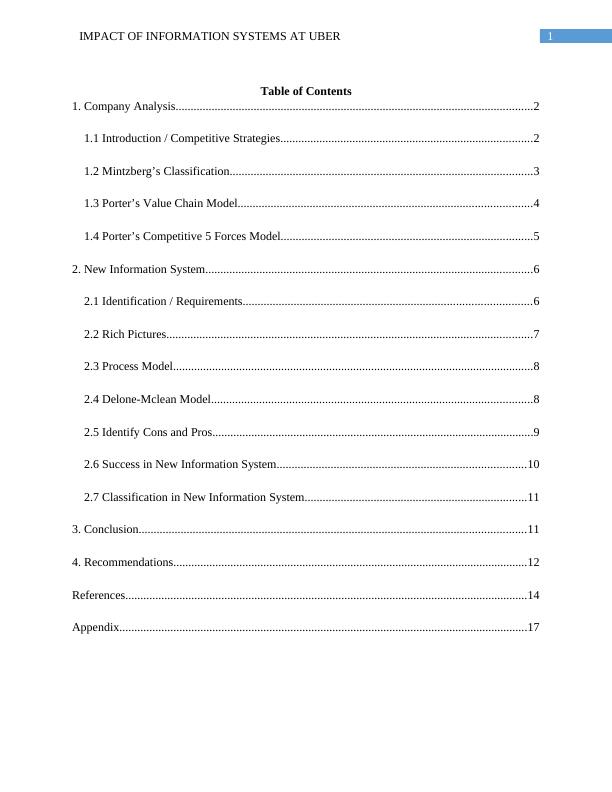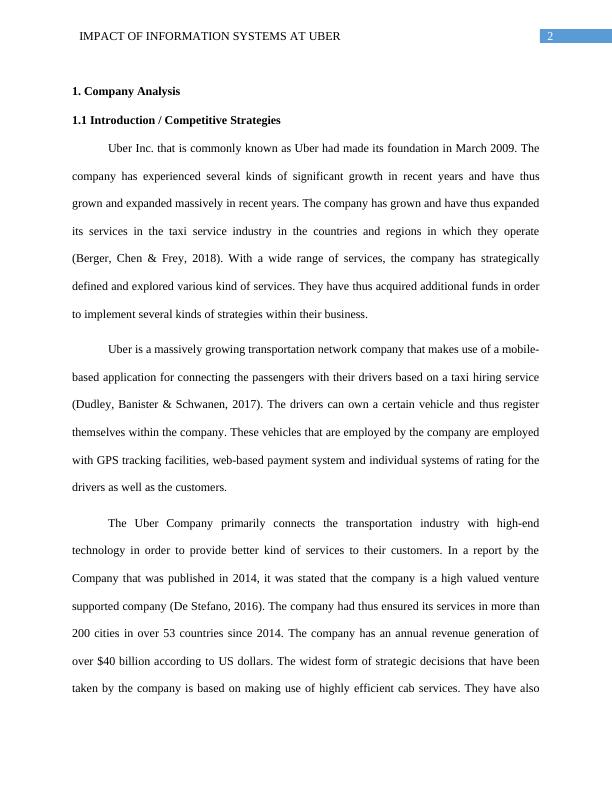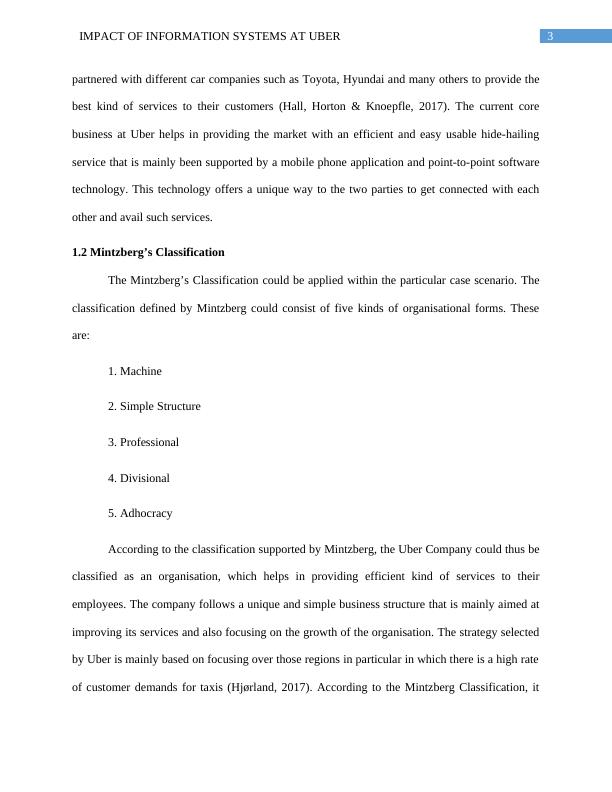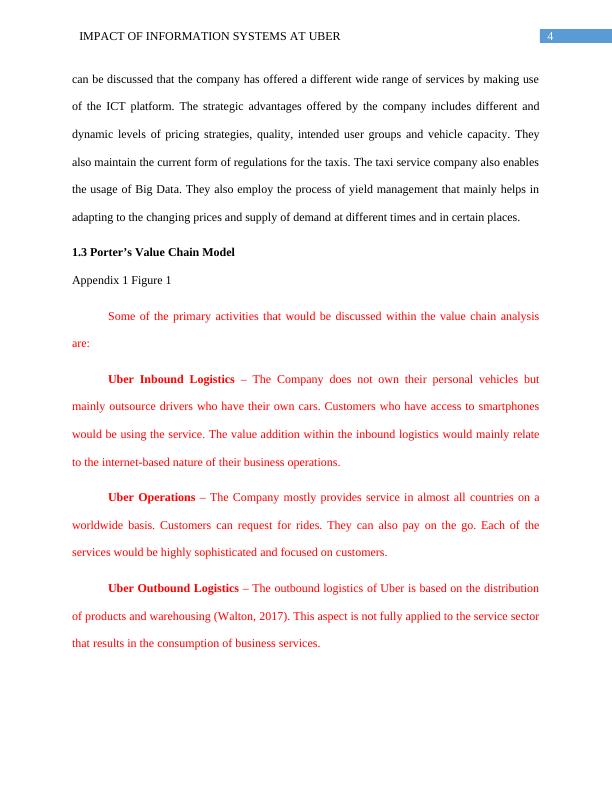Impact of Information Systems at Uber
Added on 2023-01-18
21 Pages5026 Words93 Views
Running head: IMPACT OF INFORMATION SYSTEMS AT UBER
Impact of Information Systems at Uber
Name of the Student
Name of the University
Author’s note
Impact of Information Systems at Uber
Name of the Student
Name of the University
Author’s note

1IMPACT OF INFORMATION SYSTEMS AT UBER
Table of Contents
1. Company Analysis.......................................................................................................................2
1.1 Introduction / Competitive Strategies....................................................................................2
1.2 Mintzberg’s Classification.....................................................................................................3
1.3 Porter’s Value Chain Model..................................................................................................4
1.4 Porter’s Competitive 5 Forces Model....................................................................................5
2. New Information System.............................................................................................................6
2.1 Identification / Requirements................................................................................................6
2.2 Rich Pictures..........................................................................................................................7
2.3 Process Model........................................................................................................................8
2.4 Delone-Mclean Model...........................................................................................................8
2.5 Identify Cons and Pros...........................................................................................................9
2.6 Success in New Information System...................................................................................10
2.7 Classification in New Information System..........................................................................11
3. Conclusion.................................................................................................................................11
4. Recommendations......................................................................................................................12
References......................................................................................................................................14
Appendix........................................................................................................................................17
Table of Contents
1. Company Analysis.......................................................................................................................2
1.1 Introduction / Competitive Strategies....................................................................................2
1.2 Mintzberg’s Classification.....................................................................................................3
1.3 Porter’s Value Chain Model..................................................................................................4
1.4 Porter’s Competitive 5 Forces Model....................................................................................5
2. New Information System.............................................................................................................6
2.1 Identification / Requirements................................................................................................6
2.2 Rich Pictures..........................................................................................................................7
2.3 Process Model........................................................................................................................8
2.4 Delone-Mclean Model...........................................................................................................8
2.5 Identify Cons and Pros...........................................................................................................9
2.6 Success in New Information System...................................................................................10
2.7 Classification in New Information System..........................................................................11
3. Conclusion.................................................................................................................................11
4. Recommendations......................................................................................................................12
References......................................................................................................................................14
Appendix........................................................................................................................................17

2IMPACT OF INFORMATION SYSTEMS AT UBER
1. Company Analysis
1.1 Introduction / Competitive Strategies
Uber Inc. that is commonly known as Uber had made its foundation in March 2009. The
company has experienced several kinds of significant growth in recent years and have thus
grown and expanded massively in recent years. The company has grown and have thus expanded
its services in the taxi service industry in the countries and regions in which they operate
(Berger, Chen & Frey, 2018). With a wide range of services, the company has strategically
defined and explored various kind of services. They have thus acquired additional funds in order
to implement several kinds of strategies within their business.
Uber is a massively growing transportation network company that makes use of a mobile-
based application for connecting the passengers with their drivers based on a taxi hiring service
(Dudley, Banister & Schwanen, 2017). The drivers can own a certain vehicle and thus register
themselves within the company. These vehicles that are employed by the company are employed
with GPS tracking facilities, web-based payment system and individual systems of rating for the
drivers as well as the customers.
The Uber Company primarily connects the transportation industry with high-end
technology in order to provide better kind of services to their customers. In a report by the
Company that was published in 2014, it was stated that the company is a high valued venture
supported company (De Stefano, 2016). The company had thus ensured its services in more than
200 cities in over 53 countries since 2014. The company has an annual revenue generation of
over $40 billion according to US dollars. The widest form of strategic decisions that have been
taken by the company is based on making use of highly efficient cab services. They have also
1. Company Analysis
1.1 Introduction / Competitive Strategies
Uber Inc. that is commonly known as Uber had made its foundation in March 2009. The
company has experienced several kinds of significant growth in recent years and have thus
grown and expanded massively in recent years. The company has grown and have thus expanded
its services in the taxi service industry in the countries and regions in which they operate
(Berger, Chen & Frey, 2018). With a wide range of services, the company has strategically
defined and explored various kind of services. They have thus acquired additional funds in order
to implement several kinds of strategies within their business.
Uber is a massively growing transportation network company that makes use of a mobile-
based application for connecting the passengers with their drivers based on a taxi hiring service
(Dudley, Banister & Schwanen, 2017). The drivers can own a certain vehicle and thus register
themselves within the company. These vehicles that are employed by the company are employed
with GPS tracking facilities, web-based payment system and individual systems of rating for the
drivers as well as the customers.
The Uber Company primarily connects the transportation industry with high-end
technology in order to provide better kind of services to their customers. In a report by the
Company that was published in 2014, it was stated that the company is a high valued venture
supported company (De Stefano, 2016). The company had thus ensured its services in more than
200 cities in over 53 countries since 2014. The company has an annual revenue generation of
over $40 billion according to US dollars. The widest form of strategic decisions that have been
taken by the company is based on making use of highly efficient cab services. They have also

3IMPACT OF INFORMATION SYSTEMS AT UBER
partnered with different car companies such as Toyota, Hyundai and many others to provide the
best kind of services to their customers (Hall, Horton & Knoepfle, 2017). The current core
business at Uber helps in providing the market with an efficient and easy usable hide-hailing
service that is mainly been supported by a mobile phone application and point-to-point software
technology. This technology offers a unique way to the two parties to get connected with each
other and avail such services.
1.2 Mintzberg’s Classification
The Mintzberg’s Classification could be applied within the particular case scenario. The
classification defined by Mintzberg could consist of five kinds of organisational forms. These
are:
1. Machine
2. Simple Structure
3. Professional
4. Divisional
5. Adhocracy
According to the classification supported by Mintzberg, the Uber Company could thus be
classified as an organisation, which helps in providing efficient kind of services to their
employees. The company follows a unique and simple business structure that is mainly aimed at
improving its services and also focusing on the growth of the organisation. The strategy selected
by Uber is mainly based on focusing over those regions in particular in which there is a high rate
of customer demands for taxis (Hjørland, 2017). According to the Mintzberg Classification, it
partnered with different car companies such as Toyota, Hyundai and many others to provide the
best kind of services to their customers (Hall, Horton & Knoepfle, 2017). The current core
business at Uber helps in providing the market with an efficient and easy usable hide-hailing
service that is mainly been supported by a mobile phone application and point-to-point software
technology. This technology offers a unique way to the two parties to get connected with each
other and avail such services.
1.2 Mintzberg’s Classification
The Mintzberg’s Classification could be applied within the particular case scenario. The
classification defined by Mintzberg could consist of five kinds of organisational forms. These
are:
1. Machine
2. Simple Structure
3. Professional
4. Divisional
5. Adhocracy
According to the classification supported by Mintzberg, the Uber Company could thus be
classified as an organisation, which helps in providing efficient kind of services to their
employees. The company follows a unique and simple business structure that is mainly aimed at
improving its services and also focusing on the growth of the organisation. The strategy selected
by Uber is mainly based on focusing over those regions in particular in which there is a high rate
of customer demands for taxis (Hjørland, 2017). According to the Mintzberg Classification, it

4IMPACT OF INFORMATION SYSTEMS AT UBER
can be discussed that the company has offered a different wide range of services by making use
of the ICT platform. The strategic advantages offered by the company includes different and
dynamic levels of pricing strategies, quality, intended user groups and vehicle capacity. They
also maintain the current form of regulations for the taxis. The taxi service company also enables
the usage of Big Data. They also employ the process of yield management that mainly helps in
adapting to the changing prices and supply of demand at different times and in certain places.
1.3 Porter’s Value Chain Model
Appendix 1 Figure 1
Some of the primary activities that would be discussed within the value chain analysis
are:
Uber Inbound Logistics – The Company does not own their personal vehicles but
mainly outsource drivers who have their own cars. Customers who have access to smartphones
would be using the service. The value addition within the inbound logistics would mainly relate
to the internet-based nature of their business operations.
Uber Operations – The Company mostly provides service in almost all countries on a
worldwide basis. Customers can request for rides. They can also pay on the go. Each of the
services would be highly sophisticated and focused on customers.
Uber Outbound Logistics – The outbound logistics of Uber is based on the distribution
of products and warehousing (Walton, 2017). This aspect is not fully applied to the service sector
that results in the consumption of business services.
can be discussed that the company has offered a different wide range of services by making use
of the ICT platform. The strategic advantages offered by the company includes different and
dynamic levels of pricing strategies, quality, intended user groups and vehicle capacity. They
also maintain the current form of regulations for the taxis. The taxi service company also enables
the usage of Big Data. They also employ the process of yield management that mainly helps in
adapting to the changing prices and supply of demand at different times and in certain places.
1.3 Porter’s Value Chain Model
Appendix 1 Figure 1
Some of the primary activities that would be discussed within the value chain analysis
are:
Uber Inbound Logistics – The Company does not own their personal vehicles but
mainly outsource drivers who have their own cars. Customers who have access to smartphones
would be using the service. The value addition within the inbound logistics would mainly relate
to the internet-based nature of their business operations.
Uber Operations – The Company mostly provides service in almost all countries on a
worldwide basis. Customers can request for rides. They can also pay on the go. Each of the
services would be highly sophisticated and focused on customers.
Uber Outbound Logistics – The outbound logistics of Uber is based on the distribution
of products and warehousing (Walton, 2017). This aspect is not fully applied to the service sector
that results in the consumption of business services.

5IMPACT OF INFORMATION SYSTEMS AT UBER
Uber Marketing and Sales – The Company is mostly dependent on social media
marketing and other marketing strategies based on communicating the marketing message. After
a particular ride, the customer is automatically charged with the help of a credit card.
Uber Service – The providing of a high form of customer service is discussed as the core
competencies as it would help in gaining the attention of customers. Riders would be able to rate
their drivers after the completion of the journey.
1.4 Porter’s Competitive 5 Forces Model
Forces Strength of the
Forces
Explanation of the Strength
Bargaining
power of
Customers
Differentiation There are a wide number of customers who make use of the
necessary services provided by the company. There are also
some specific circumstances in which the company makes
use of valuable services (Rogers, 2015). There is also a wide
range of other taxi service providers that include Lyft and
many others that have emerged in the competitive market.
The switching cost for users within the company is also low.
This is mainly due to the reason that the free application
software provided by Uber demands free customer
registration.
Bargaining
power of
Suppliers
Niche The company does not own any of the fleets of cars. The
business model owned by the company is primarily
dependent on their business partners and drivers who would
own their own cars. Uber primarily makes use of an
outsourcing technological system for their labour and assets.
Uber also finds it extremely hard to substitute their drivers
(Dallas, Ponte & Sturgeon, 2017). The car owners have the
freedom to choose between different organizations. This
helps the car owners to negotiate between different firms
The threat
of new
entrants
Innovation The Uber Company faces lack of protection based from ride-
sharing firms. The primary policy of Uber is to offer
innovative application software for willing customers. The
company is not immune to raise the rates (Christensen,
Raynor & McDonald, 2015). This further boosts other
competitor firms to penetrate within the industry and thus
Uber Marketing and Sales – The Company is mostly dependent on social media
marketing and other marketing strategies based on communicating the marketing message. After
a particular ride, the customer is automatically charged with the help of a credit card.
Uber Service – The providing of a high form of customer service is discussed as the core
competencies as it would help in gaining the attention of customers. Riders would be able to rate
their drivers after the completion of the journey.
1.4 Porter’s Competitive 5 Forces Model
Forces Strength of the
Forces
Explanation of the Strength
Bargaining
power of
Customers
Differentiation There are a wide number of customers who make use of the
necessary services provided by the company. There are also
some specific circumstances in which the company makes
use of valuable services (Rogers, 2015). There is also a wide
range of other taxi service providers that include Lyft and
many others that have emerged in the competitive market.
The switching cost for users within the company is also low.
This is mainly due to the reason that the free application
software provided by Uber demands free customer
registration.
Bargaining
power of
Suppliers
Niche The company does not own any of the fleets of cars. The
business model owned by the company is primarily
dependent on their business partners and drivers who would
own their own cars. Uber primarily makes use of an
outsourcing technological system for their labour and assets.
Uber also finds it extremely hard to substitute their drivers
(Dallas, Ponte & Sturgeon, 2017). The car owners have the
freedom to choose between different organizations. This
helps the car owners to negotiate between different firms
The threat
of new
entrants
Innovation The Uber Company faces lack of protection based from ride-
sharing firms. The primary policy of Uber is to offer
innovative application software for willing customers. The
company is not immune to raise the rates (Christensen,
Raynor & McDonald, 2015). This further boosts other
competitor firms to penetrate within the industry and thus

End of preview
Want to access all the pages? Upload your documents or become a member.
Related Documents
Disruptive Innovation- Impact of e-hailing ride services on the financial, health, mental wellbeing and social aspects of lives of Taxi Drivers in Kuala Lumpurlg...
|28
|9048
|160
Project Proposal of Improving Market Share of Taxilg...
|39
|6000
|270
Uber - Hits a Bump in the Roadlg...
|15
|535
|355
Business Strategy of Uber Technologylg...
|13
|3535
|40
Uber vs. Taxi: A War of Innovative and Technological Standardslg...
|17
|4174
|138
Ingogo Company: Background, Industry, Customer, Competitor, SWOT Analysislg...
|11
|1059
|113
